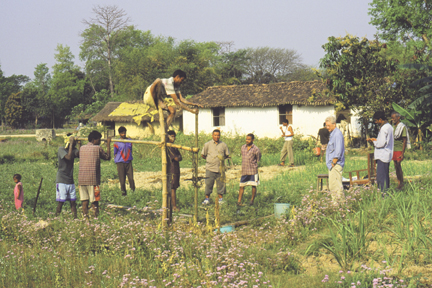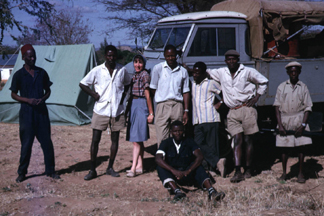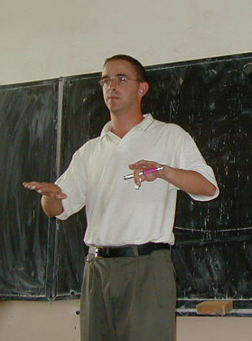Geotimes

Feature
Geoscientists in
the Peace Corps: A Strategic Revisit
David Hastings
 The Peace Corps
was founded in 1961 by John F. Kennedy and the Congressional Peace Corps Act.
Under Director Sargent Shriver, the young organization quickly garnered attention
for its dynamic and youthful (although of all ages) volunteers. The principles
of helping poor people, personal growth for volunteers and international friendship
for the United States have attracted and changed the lives of many Americans.
According to Peace Corps figures, 170,000 volunteers have served in 136 countries.
Despite occasional controversy about using citizen volunteers as instruments
of American foreign policy, the U.S. Peace Corps model spawned the creation
of similar volunteer programs around the world, including in Canada, the United
Kingdom, Sweden, France and Japan.
The Peace Corps
was founded in 1961 by John F. Kennedy and the Congressional Peace Corps Act.
Under Director Sargent Shriver, the young organization quickly garnered attention
for its dynamic and youthful (although of all ages) volunteers. The principles
of helping poor people, personal growth for volunteers and international friendship
for the United States have attracted and changed the lives of many Americans.
According to Peace Corps figures, 170,000 volunteers have served in 136 countries.
Despite occasional controversy about using citizen volunteers as instruments
of American foreign policy, the U.S. Peace Corps model spawned the creation
of similar volunteer programs around the world, including in Canada, the United
Kingdom, Sweden, France and Japan.
Van Williams, who worked with the Peace Corps in 1966 in Nepal, returned to
the country in 2003 to work with current Peace Corps volunteers on arsenic contamination.
Shown here in 2003, Williams (third from right) is working with local villagers
in Ujaini to use traditional drills to collect sediment samples from an arsenic
contaminated aquifer. Courtesy of Van Williams.
Each American president has molded the Peace Corps partly to suit his personal
vision. Early areas of emphasis were dominated by teaching and community development
activities. Small business advisors and technologists were given increased emphasis
in the Nixon administration. After the end of the Soviet Union, the Peace Corps
was adjusted to supply low-cost American assistance to restructuring efforts
in former Soviet republics.
Geoscientists, however, did not follow that trend. They were in demand from
several countries right from the beginning in the early 1960s (Geotimes,
May/June 1963). In fact, several now-prominent members of the geoscience community
began their careers in the Peace Corps — including Robert Fakundiny, the
long-term director of the New York State Geological Survey, as well as staffers
at the U.S. Geological Survey, Bureau of Land Management, Department of Energy,
National Forest Service, National Oceanic and Atmospheric Administration and
NASA, as well as in industry, politics and academia.
Despite their past successful roles, geoscientists and other potentially valuable
professionals appear to be low priority in recent Peace Corps administrations.
Do geoscientists fit with the current Peace Corps?
A reunion
This question prompted a special session at last November’s Geological
Society of America (GSA) annual meeting to discuss the contribution of Peace
Corps geologists to international development and how the Peace Corps experience
has helped the development of the geosciences in America. The session also served
as a forum for assessing the current situation faced by geoscientists and like
professionals interested in serving their nation and the world through the Peace
Corps, Canadian University Service Overseas (CUSO) or other such organizations.
Additionally, the event was a reunion for about 40 former volunteer geoscientists
(and some spouses).
The organizers of the session compiled a list of about 100 former Peace Corps
and CUSO volunteer geoscientists who had served in 19 countries. A questionnaire
circulated last summer received more than a dozen very detailed replies, which
are used in this article. Through generous travel support from the Kaiser Foundation,
G.O. Kesse, who is former director of the Ghana Geological Survey (1973-1993)
and a former vice president of the International Union of Geological Sciences,
was able to attend.
The Peace Corps experience
Case histories presented at the GSA meeting and elsewhere have confirmed that
most volunteers consider their experience to be one of the most important periods
of their lives. Former Peace Corps volunteer geoscientists say that almost every
imaginable circumstance has occurred. Some had their expectations exceeded with
an excellent professional match; others took a break from their originally intended
career path; still others used the experience to redefine their future career
goals.
At a minimum, the Peace Corps served as an employment agency with an umbilical
cord (in-country medical care, and the right to “bail out” early if
things were not good). Most volunteers came with only what they put in their
suitcases and were given in-country training, which sometimes, but not always,
included supplementation in the context of their professions. Much more rarely
at the other extreme, some volunteers in Ghana Geological Survey programs of
the 1960s received specialist training, vehicles, field equipment and special
allowances.
Several Peace Corps volunteers returned with a new global perspective, incorporating
international activities and concerns into their lives ever since. Others gained
positions of greater responsibility than they could have imagined before they
left home. Many volunteers saw tangible results: increased knowledge of the
geologic environment and resources of their host countries, as well as strong
professional and personal ties between themselves, the United States and host
country institutions emanating from their Peace Corps service.
Planning for the future
Sen. Norm Coleman (R-Minn.), who as chairman of the Senate Foreign Relations
subcommittee on the Western Hemisphere, Peace Corps and Narcotic Affairs is
influential over the Peace Corps budget, has stated that he wants greater accountability
of the Peace Corps for how it spends its funding. Most volunteers appear to
agree that the Peace Corps is doing many things well by providing fairly well-run
recruiting, application and screening procedures, training and in-country support,
at least for mainstream volunteers who, for example, teach in secondary schools.
However, if Sen. Coleman’s call for greater accountability extends to management
as well as budget, the former Peace Corps volunteer geoscientists have some
suggestions.
For the volunteer geoscientists, “accountability” may translate to
better appreciation by Peace Corps management of the diversity of the types
of volunteer positions. Many former volunteers noted that merely placing a “warm
body” with a host country agency may be inadequate, if that agency lacks
certain essentials for effective work.
Although early Peace Corps volunteers assigned to the Ghana Geological Survey
in the 1960s were well-equipped and given extensive specialist training in the
United States and Ghana, the last volunteers assigned to Ghana in the 1970s
came without such equipment and were given largely the same training as other
volunteers (minus the secondary school teacher training). It is important that
the volunteers have at least the basics to conduct their work. If the current
Peace Corps does not engage well with the concept of professionals as volunteers,
perhaps it’s time to consider another vehicle for sending volunteer geologists
abroad.
For its own support of professionals, the United States might consider models
used (at least at one time, if not at present) in other countries. Some organizations,
such as the Canadian International Development Agency and the United Nations
Development Programme placed professionals in developing country institutions
on contracts of a few years, paying them professional salaries with benefits.
Thus mid-career professionals were able to afford such work.
Some countries, for example the United Kingdom and the Netherlands, had salary
supplementation schemes, such as the British Expatriates Supplementation Scheme
(BESS). Under this program, professionals would apply for normally advertised
vacancies, such as for teaching faculty of a university in a developing country,
a national geological survey or forestry department. If accepted, BESS offered
salary supplementation and other benefits to enable the professionals to afford
working in the developing country and still be able to retire back home.
Such avenues lack certain aspects of the “Peace Corps experience.”
But a variation on such a program might be worth considering if the Peace Corps
cannot adequately respond to concerns about professionals as volunteers.
A new bureaucratic body need not necessarily be created. Perhaps a U.S. funding
agency and a contractor (such as a consortium of universities) could fund and
administer the program. Perhaps Michigan Technological University’s master’s
degree program using Peace Corps service could be extended to Ph.D. or non-degree
research and development. Perhaps the Peace Corps could be the contractor for
the recruitment and in-country support of such volunteers, with a consortium
of agencies handling the extra support to make such volunteers more effective.
Additionally, the Peace Corps process could be improved both at the recruitment
end and for when the volunteers go home. During recruitment, communication could
be stronger: A former volunteer (who wishes to remain anonymous) recalls the
Peace Corps painting a very gloomy picture of working conditions at a university
in which he was to be placed. After reading that the university had virtually
no equipment in the labs and few books or journals in the library, the apprehensive
volunteer was able to convince the Peace Corps to pay to ship his library of
professional books and journals to his job site.
To his pleasant surprise, the volunteer found a fairly well stocked library
and well-equipped laboratories upon his arrival. To top things off, nearby governmental
institutions had additional field equipment available for loan if he worked
cooperatively with them. He wound up extending his tour modestly to help a master’s
degree student complete his studies, then returned to the country later to work
for three invaluable years. Now 30 years later, he is grateful that he was not
put off by that unnecessarily gloomy description by the Peace Corps.
On the return end, most volunteers have experienced some challenges in adjusting
to life back in the United States (see sidebar). This
may be even tougher for any possible present-day Peace Corps volunteer geoscientists
who plan to enter the job market immediately after return, rather than going
back to campus. Between the tight job market for geoscientists and other factors
encountered by many volunteers, more support might be worthwhile.
To that end, former geoscience volunteers suggested creating an optional workshop
covering topics common to returning volunteers. These could be held several
times a year, in locations where returned Peace Corps volunteers tend to congregate.
The Peace Corps currently offers limited counseling facilities for returned
volunteers.
At November’s gathering, the retired Peace Corps volunteer geoscientists
agreed that the Peace Corps, or other similar national volunteer organizations,
can provide unique opportunities for geoscientists and other professionals.
However, as the Peace Corps passes into middle age, it is time to reevaluate
some of its features and history, seeking to refine management to better handle
professionals in its ranks. Many ideas for professional service sit on the shelf
from past Peace Corps efforts, along with those of other volunteer and foreign
assistance organizations. If the Peace Corps does not address such issues, perhaps
an alternative structure can better support professionals in voluntary service.
| An
American geologist in Tanzania
From 1964 to 1966, Eleanora (Norrie) Iberall Robbins served as a Peace
Corps volunteer with the Tanzania Geological Survey (TGS), immediately
following receipt of her bachelor’s degree from Ohio State University.
Stationed in Dodoma in the days before computers, her assignment was to
search anomalous values in notebooks of stream sediment geochemical data
taken by Williamson’s Diamonds.
 Eleanora
(Norrie) Iberall Robbins leaves with crew for field work in Kondoa, Tanzania,
in 1965.Courtesy of Norrie Robbins. Eleanora
(Norrie) Iberall Robbins leaves with crew for field work in Kondoa, Tanzania,
in 1965.Courtesy of Norrie Robbins.
“None of the men at TGS wanted the job,” Robbins recalls, “so
the survey decided this would be a perfect assignment for a female Peace
Corps geologist.” She became the first woman sent out in charge of
a field party. And for her vacation, Robbins volunteered for Louis Leakey,
mapping the Olorgesailie hand-axe site in the Great Rift Valley in Kenya.
Successful Peace Corps service, Robbins says, gave her noncompetitive
eligibility for a U.S. government job; she was hired by the U.S. Geological
Survey (USGS) in 1967 based on her foreign experience. One assignment
at USGS focused on the economic deposits in the Early Mesozoic (rift)
basins of the eastern United States. Robbins was able to apply insights
from her Peace Corps mapping in the Great Rift Valley of Kenya to the
coal, petroleum and mineral deposits of Virginia and North Carolina.
Through correspondence with Philip Momburi, a current geologist at TGS
in Dodoma, she continued pursuing her “lifelong interest in trace
metals in the environment.” Momburi is researching human bioaccumulation
of deleterious trace elements.
Now retired from the USGS and serving as adjunct faculty at San Diego
State University, Robbins teamed up with Momburi to present their work
at last November’s Geological Society of America meeting in Seattle,
as part of a session on the emerging field of geology and human health.
|
Making
an impact in Bulgaria
Jake Cinnamon spent his Peace Corps experience living in a small town called
Omurtag in Bulgaria, and working as an environmental consultant. Cinnamon,
age 27, has a degree in geology from the University of Colorado, but he
“never used it much,” he says. “I went directly into the Peace Corps.”
 Jake
Cinnamon lectures ninth-grade students in Panagyurishte, Bulgaria, on structural
geology during his recent Peace Corps service. Courtesy of Jake Cinnamon. Jake
Cinnamon lectures ninth-grade students in Panagyurishte, Bulgaria, on structural
geology during his recent Peace Corps service. Courtesy of Jake Cinnamon.
Starting in the summer of 2001, Cinnamon worked on a variety of basic environmental
programs, including energy efficiency and choosing new street lights for
the town. He had the opportunity to discuss environmental impacts of mining
with local geologists who were exploring sites in the region, and he says
he also worked on issues for a cheese factory that “spit out enzymes into
the river — one of my jobs was to figure out how to clean it up.”
Cinnamon also worked on non-geology-related projects. He wrote grants for
a local school, capturing $15,000 to buy three new computers and a digital
camera, and he arranged for Internet access. “These kids had never seen
the Internet before,” he says.
Since Cinnamon returned to the United States last August, he has been unsure
if he wants to pursue geology as a career — a common challenge facing
returning volunteers. Instead, he is looking into working with geographic
information systems and government relations, or what he calls “the business
side of geology.” |
Hastings works for the United
Nations Economic and Social Commission for Asia and the Pacific in Bangkok, Thailand.
He served in the Peace Corps from 1972 to 1974 in Ghana. After leaving the Peace
Corps, he joined the Ghana Geological Survey until 1978, and then worked in the
United States until 2002.
This article is based on many of the opinions expressed at the Geological Society
of America meeting last November, during a session about geologists in the Peace
Corps, organized by Robert A. Levich, R. Stephen Saunders, Ernest W. Kendall and
others.
Back to top
 The Peace Corps
was founded in 1961 by John F. Kennedy and the Congressional Peace Corps Act.
Under Director Sargent Shriver, the young organization quickly garnered attention
for its dynamic and youthful (although of all ages) volunteers. The principles
of helping poor people, personal growth for volunteers and international friendship
for the United States have attracted and changed the lives of many Americans.
According to Peace Corps figures, 170,000 volunteers have served in 136 countries.
Despite occasional controversy about using citizen volunteers as instruments
of American foreign policy, the U.S. Peace Corps model spawned the creation
of similar volunteer programs around the world, including in Canada, the United
Kingdom, Sweden, France and Japan.
The Peace Corps
was founded in 1961 by John F. Kennedy and the Congressional Peace Corps Act.
Under Director Sargent Shriver, the young organization quickly garnered attention
for its dynamic and youthful (although of all ages) volunteers. The principles
of helping poor people, personal growth for volunteers and international friendship
for the United States have attracted and changed the lives of many Americans.
According to Peace Corps figures, 170,000 volunteers have served in 136 countries.
Despite occasional controversy about using citizen volunteers as instruments
of American foreign policy, the U.S. Peace Corps model spawned the creation
of similar volunteer programs around the world, including in Canada, the United
Kingdom, Sweden, France and Japan.
 Eleanora
(Norrie) Iberall Robbins leaves with crew for field work in Kondoa, Tanzania,
in 1965.Courtesy of Norrie Robbins.
Eleanora
(Norrie) Iberall Robbins leaves with crew for field work in Kondoa, Tanzania,
in 1965.Courtesy of Norrie Robbins. Jake
Cinnamon lectures ninth-grade students in Panagyurishte, Bulgaria, on structural
geology during his recent Peace Corps service. Courtesy of Jake Cinnamon.
Jake
Cinnamon lectures ninth-grade students in Panagyurishte, Bulgaria, on structural
geology during his recent Peace Corps service. Courtesy of Jake Cinnamon.